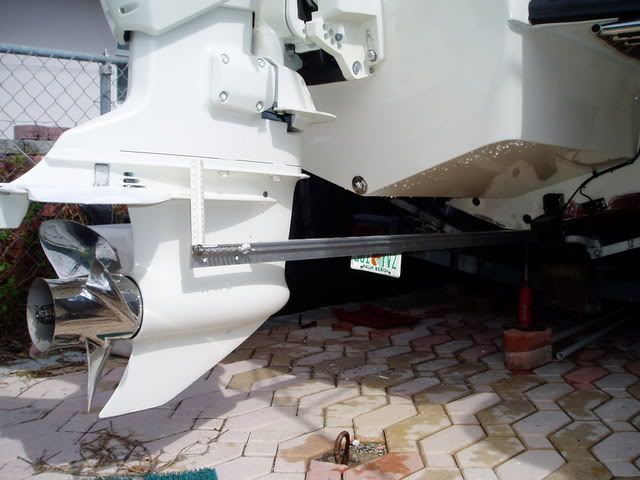Quote:
If you raise the motor one inch per foot of setback and you start with it 1 1/2" up from the keel, I assume my cavitation plate should be around 3 1/2" above the keel? How much distance should I put between the keel and the bottom of the flotation chamber? Should the chamber then taper up or continue parallel to the keel?
|
Bits - Great job of recovering boat and saving that motor! I think you've also figured out why I decided to close in my transom and add a bracket!
3.5" cav plate height above keel is just about right on my rig - it's one of Don's brackets with 30" setback. (See following pics.) I raised motor 2 holes from where Don mounted initially and picked up some performance, but don't think I can go much higher without prop ventilation and handling issues.


Bottom of flotation tank should come straight back to get max flotation. Hermco is the only bracket I've seen like that; I think Armstrong and the others are losing a lot of flotation with the sloped bottom! Bottom of my bracket is about 4" above keel. I did some measurements and calcs last weekend and it looks like my flotation tank sits about about 10.75" deep in water, which works out to about 283 lbs of positive flotation. (Note: if entire tank in submerged, total positive flotation is about 485 lbs) Waterline at the transom looks to be 4-4.5" above chine.

Putting tank bottom closer to keel would provide even more flotation, but I don't know if there are any downsides to getting it too close to bottom. I believe one advantage of bracket is that it puts motor further behind boat in "cleaner" water, so that implies you need some sort of vertical step in the running surface to get it out of the water. Minimum step height would depend on running angle; when you're first coming up on plane, that long straight bottom on tank should act like a big trim tab while it's still in the water.
One other consideration with a bracket is that once you're up on plane the flotation tank isn't doing anything, but the rearward shift of the motor has shifted CG of the boat aft. (Do a search for my previous post on pro's & con's of brackets, done a few weeks ago.) This will tend to raise the bow and help top speed, but it'll hurt ride in rough water and will tend to increase your min planning speed. I found that I needed a stern lifting prop and doelfin to get my min planning speed down to ~12 mph where it was with my old 300 lb motor hanging on the transom. CC's are more stern-heavy than the Seafari, so this effect might be more pronounced on your boat. I'm running a 429 lb motor with 30" setback and boat is just barely self-bailing with no one aboard. 450 lb motor with 24" setback is probably similar, except that I have more weight forward. If I had it to do over again, I'd go with a 24" setback and possibly a lighter motor, maybe a 115. That "150" (165) will push the boat to almost 50 mph, waay more speed than I really need! (But it IS fun!) Denny